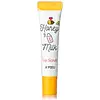What's inside
What's inside
 Key Ingredients
Key Ingredients

 Benefits
Benefits

 Concerns
Concerns

 Ingredients Side-by-side
Ingredients Side-by-side

Water
Skin ConditioningParaffinum Liquidum
EmollientJuglans Regia Shell Powder
AbrasiveCetearyl Alcohol
EmollientGlyceryl Stearate
EmollientPolysorbate 60
EmulsifyingHoney Extract
HumectantMilk Protein Extract
Glycerin
HumectantStearic Acid
CleansingPEG-100 Stearate
1,2-Hexanediol
Skin ConditioningSorbitan Stearate
EmulsifyingHydroxyethyl Acrylate/Sodium Acryloyldimethyl Taurate Copolymer
Emulsion StabilisingDimethicone
EmollientCaprylyl Glycol
EmollientTriethanolamine
BufferingSqualane
EmollientTocopheryl Acetate
AntioxidantSorbitan Isostearate
EmulsifyingCyclopentasiloxane
EmollientDimethicone/Vinyl Dimethicone Crosspolymer
Skin ConditioningCarbomer
Emulsion StabilisingPhenoxyethanol
PreservativeDisodium EDTA
Parfum
MaskingCI 77891
Cosmetic ColorantWater, Paraffinum Liquidum, Juglans Regia Shell Powder, Cetearyl Alcohol, Glyceryl Stearate, Polysorbate 60, Honey Extract, Milk Protein Extract, Glycerin, Stearic Acid, PEG-100 Stearate, 1,2-Hexanediol, Sorbitan Stearate, Hydroxyethyl Acrylate/Sodium Acryloyldimethyl Taurate Copolymer, Dimethicone, Caprylyl Glycol, Triethanolamine, Squalane, Tocopheryl Acetate, Sorbitan Isostearate, Cyclopentasiloxane, Dimethicone/Vinyl Dimethicone Crosspolymer, Carbomer, Phenoxyethanol, Disodium EDTA, Parfum, CI 77891
Water
Skin ConditioningCellulose
AbsorbentDipropylene Glycol
HumectantLauryl Hydroxysultaine
CleansingSodium Cocoyl Alaninate
Methyl Perfluorobutyl Ether
SolventMethyl Perfluoroisobutyl Ether
SolventAcrylates/C10-30 Alkyl Acrylate Crosspolymer
Emulsion StabilisingGlycerin
HumectantQuillaja Saponaria Bark Extract
CleansingPseudoalteromonas Ferment Extract
HumectantButylene Glycol
Humectant1,2-Hexanediol
Skin ConditioningCoco-Glucoside
CleansingGluconolactone
Skin ConditioningLactobionic Acid
BufferingSodium Cocoyl Isethionate
CleansingCitric Acid
BufferingCaprylyl Glycol
EmollientEthylhexylglycerin
Skin ConditioningCyanocobalamin
Skin ConditioningAlanine
MaskingProline
Skin ConditioningSerine
MaskingSodium Phosphate
BufferingSodium Hydroxide
BufferingXanthan Gum
EmulsifyingParfum
MaskingWater, Cellulose, Dipropylene Glycol, Lauryl Hydroxysultaine, Sodium Cocoyl Alaninate, Methyl Perfluorobutyl Ether, Methyl Perfluoroisobutyl Ether, Acrylates/C10-30 Alkyl Acrylate Crosspolymer, Glycerin, Quillaja Saponaria Bark Extract, Pseudoalteromonas Ferment Extract, Butylene Glycol, 1,2-Hexanediol, Coco-Glucoside, Gluconolactone, Lactobionic Acid, Sodium Cocoyl Isethionate, Citric Acid, Caprylyl Glycol, Ethylhexylglycerin, Cyanocobalamin, Alanine, Proline, Serine, Sodium Phosphate, Sodium Hydroxide, Xanthan Gum, Parfum
Alternatives
Ingredients Explained
These ingredients are found in both products.
Ingredients higher up in an ingredient list are typically present in a larger amount.
1,2-Hexanediol is a synthetic liquid and another multi-functional powerhouse.
It is a:
- Humectant, drawing moisture into the skin
- Emollient, helping to soften skin
- Solvent, dispersing and stabilizing formulas
- Preservative booster, enhancing the antimicrobial activity of other preservatives
Caprylyl Glycol is a humectant and emollient, meaning it attracts and preserves moisture.
It is a common ingredient in many products, especially those designed to hydrate skin. The primary benefits are retaining moisture, skin softening, and promoting a healthy skin barrier.
Though Caprylyl Glycol is an alcohol derived from fatty acids, it is not the kind that can dry out skin.
This ingredient is also used as a preservative to extend the life of products. It has slight antimicrobial properties.
Learn more about Caprylyl GlycolGlycerin is already naturally found in your skin. It helps moisturize and protect your skin.
A study from 2016 found glycerin to be more effective as a humectant than AHAs and hyaluronic acid.
As a humectant, it helps the skin stay hydrated by pulling moisture to your skin. The low molecular weight of glycerin allows it to pull moisture into the deeper layers of your skin.
Hydrated skin improves your skin barrier; Your skin barrier helps protect against irritants and bacteria.
Glycerin has also been found to have antimicrobial and antiviral properties. Due to these properties, glycerin is often used in wound and burn treatments.
In cosmetics, glycerin is usually derived from plants such as soybean or palm. However, it can also be sourced from animals, such as tallow or animal fat.
This ingredient is organic, colorless, odorless, and non-toxic.
Glycerin is the name for this ingredient in American English. British English uses Glycerol/Glycerine.
Learn more about GlycerinParfum is a catch-all term for an ingredient or more that is used to give a scent to products.
Also called "fragrance", this ingredient can be a blend of hundreds of chemicals or plant oils. This means every product with "fragrance" or "parfum" in the ingredients list is a different mixture.
For instance, Habanolide is a proprietary trade name for a specific aroma chemical. When used as a fragrance ingredient in cosmetics, most aroma chemicals fall under the broad labeling category of “FRAGRANCE” or “PARFUM” according to EU and US regulations.
The term 'parfum' or 'fragrance' is not regulated in many countries. In many cases, it is up to the brand to define this term.
For instance, many brands choose to label themselves as "fragrance-free" because they are not using synthetic fragrances. However, their products may still contain ingredients such as essential oils that are considered a fragrance by INCI standards.
One example is Calendula flower extract. Calendula is an essential oil that still imparts a scent or 'fragrance'.
Depending on the blend, the ingredients in the mixture can cause allergies and sensitivities on the skin. Some ingredients that are known EU allergens include linalool and citronellol.
Parfum can also be used to mask or cover an unpleasant scent.
The bottom line is: not all fragrances/parfum/ingredients are created equally. If you are worried about fragrances, we recommend taking a closer look at an ingredient. And of course, we always recommend speaking with a professional.
Learn more about ParfumWater. It's the most common cosmetic ingredient of all. You'll usually see it at the top of ingredient lists, meaning that it makes up the largest part of the product.
So why is it so popular? Water most often acts as a solvent - this means that it helps dissolve other ingredients into the formulation.
You'll also recognize water as that liquid we all need to stay alive. If you see this, drink a glass of water. Stay hydrated!
Learn more about Water